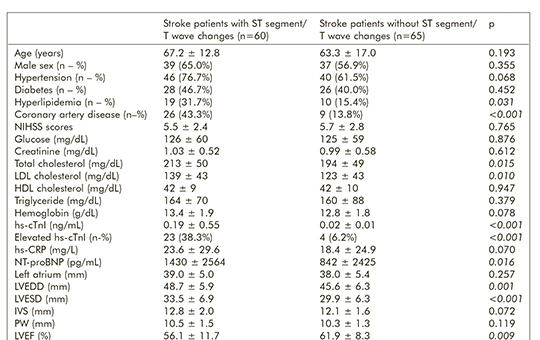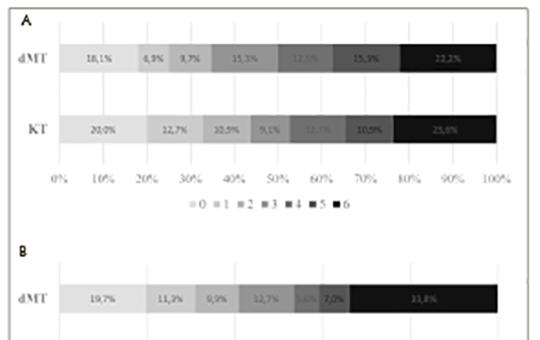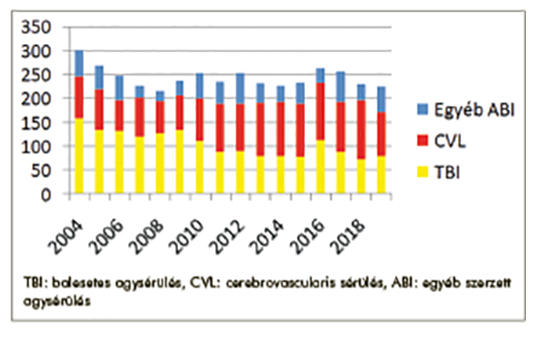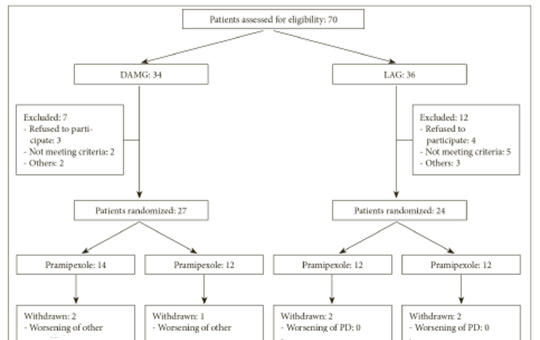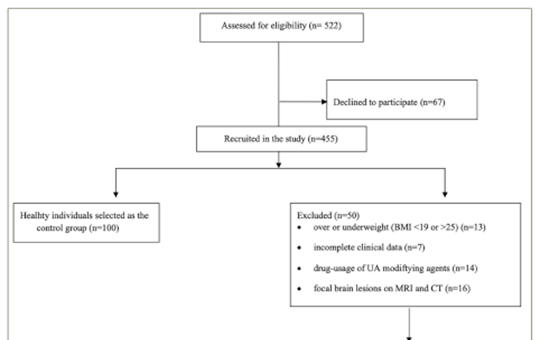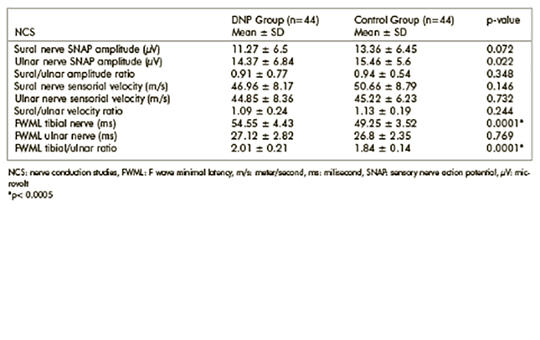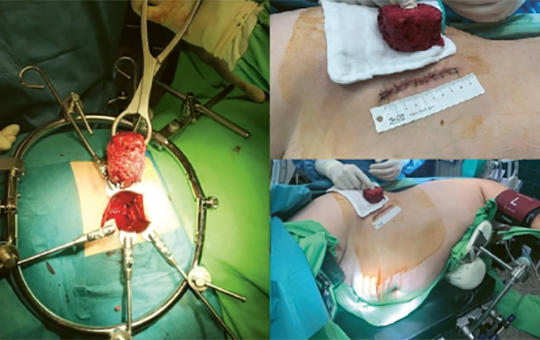The eLitMed.hu medical portal uses computer cookies for convenient operation. Detailed information can be found in the Cookie-policy.
Clinical Neuroscience - 2022;75(01-02)
Content
The effect of starting a meal with salt and date palm on taste impairment caused by COVID-19
This study was conducted to examine the effect of starting a meal with salt and date palm on the sense of taste in COVID-19 patients. This study was conducted using a randomized controlled method. Patient and disease information forms and Visual Analog Scale were used for data collection. Salt and date palm were used to stimulate the sense of taste in two different experimental groups. No procedure was made in the control group except for the practice of the clinic. The results were analyzed using SPSS version 25. The mean ages of all groups were between 43.42 ± 8.60 and 47.22 ± 12.04 years. Fever, sore throat, dry mouth, cough, muscle weakness, and similar symptoms were present in all groups. Significant improvements were found in patients with hypoageusia and ageusia after date palm and salt application (p<0.01). For taste impairment caused by COVID-19, consumption of date palm and tasting very little salt for therapeutic purposes may help to alleviate taste impairment. Based on the data obtained from this study, the pathophysiology of the effects of date palm and salt on taste complications should be investigated.
Neurogenic stunned myocardium in acute ischemic stroke
Neurogenic myocardial injury occurs as a result of dysregulation of autonomic nervous system. The aim of this study was to explore the frequency of elevated troponin and dynamic ST segment/T wave changes and their relation with left ventricular (LV) systolic functions in acute ischemic stroke patients. One hundred and twenty-five patients (mean age: 65.1±15.2years, 76 male) presenting with acute ischemic stroke were consecutively included. 12-lead electrocardiogram was taken to assess dynamic ST segment/T wave changes, conventional transthoracic echocardiography to determine LV ejection fraction (LVEF). High-sensitive cardiac troponin I (hs-cTnI) level>0.04ng/mL was accepted as elevated. Twenty-seven patients (21.6%) had elevated hs-cTnI and 60 patients (48%) had dynamic ST segment/T wave changes. The stroke patients with elevated hs-cTnI had significantly higher NT-proBNP values (2302±3450pg/mL vs 799±2075pg/mL p<0.001) and higher frequency of ST segment/T wave changes (85.2% vs 37.8% p<0.001), and lower LVEF (52.2±13.6% vs 61.0±8.5% p=0.002) compared to patients with normal troponin levels. The patients with ST segment/T wave changes had significantly higher frequencies of hyperlipidemia (31.7% vs 15.4% p=0.031) and coronary artery disease (CAD) (43.3% vs 13.8% p<0.001), hs-cTnI (0.19±0.55ng/mL vs 0.02±0.01ng/mL p<0.001) and NT-proBNP levels (1430±2564pg/mL vs 842±2425pg/mL p=0.016), and lower LVEF (56.1±11.7% vs 61.9±8.3% p=0.009). Linear regression analysis revealed presence of CAD, but not ST segment/T wave changes as an independent predictor of hs-cTnI (p=0.034). LVEF was independently associated with hs-cTnI (p=0.003) and presence of CAD (p=0.009) when adjusted by age, sex and presence of ST segment/T wave changes. Troponin elevation and ST segment/T wave changes occurring in patients suffering acute ischemic stroke, especially in those with CAD, may be a sign of neurogenic stunned myocardium.
[The role of intravenous thrombolysis before mechanical thrombectomy in the treatment of large vessel occlusion strokes ]
[The efficacy of intravenous thrombolysis (IVT) is moderate in the proximal vascular segments of intracranial arteries, as opposed to mechanical thrombectomy (MT). In the management of acute ischemic stroke (AIS) caused by large vessel occlusions (LVO), IVT prior to MT is highly recommended based on the latest guidelines, but the necessity of IVT has been questioned by the latest studies of the past years. The aim of our study was to investigate and compare the efficacy and safety of direct mechanical thrombectomy (dMT) and combined therapy (CT) for patients who suffered an AIS with LVO and were treated in our department. We investigated patients with AIS caused by LVO who were admitted up to 4.5 hours after symptom onset and underwent MT in our department between November 2017 and August 2019. Patients’ data were collected in our stroke register. Patients enrolled in our study were divided into two groups depending on whether dMT or CT was used. Our primary outcome was the 30- and 90- day functional outcome measured by modified Rankin Scale (mRS). Mortality at 30- and 90- day, successful recanalization rates, and symptomatic intracranial hemorrhage were considered as secondary outcomes. A total of 142 patients (age: 68.3 ± 12.6 years, 53.5% female) were enrolled in our study, including 81 (57.0%) dMT cases, and 61 (43.0%) patients who received CT. The vascular risk factors and comorbidities were significantly higher in the dMT-treated group. At day 30, the rate of favorable functional outcomes was 34.7% in dMT vs. 43.6% among those who received CT (p = 0.307), by day 90 this ratio changed to 40.8% vs. 46.3% (p = 0.542). Mortality rates at day 30 were 22.2% and 23.6% (p = 0.851), and at day 90 33.8% and 25.9% (p = 0.343). The rate of effective recanalization was 94.2% for dMT-treated patients and 98.0% for CT-treated patients (p = 0.318). Symptomatic intracranial hemorrhage was detected in 2.5% of dMT-treated patients and 3.4% of CT-treated group (p = 0.757). Our results suggest that CT is associated with a moderately better outcome compared to dMT. IVT prior to MT did not increase the risk of symptomatic intracranial hemorrhages.]
[Rehabilitation results after severe traumatic brain injury ]
[To assess the rehabilitation outcome after severe traumatic brain injury. Retrospective evaluation of the rehabilitation process and prospective follow-up five years after discharge. Patients – Patients treated in 2013 at the Traumatic Brain Injury Unit, National Institute for Medical Rehabilitation were included in the study (n = 232). Ninety-nine of 232 patients were treated with severe traumatic brain injury. Data were available for 66/99 patients (67%). Fifty patients (13 women and 37 men) were successfully contacted for follow-up (51%), three patients deceased. The mean age of the patients was 42 years (range: 22-72). The majority of them (36/50) was injured in traffic accidents. The mean duration of coma and post-traumatic amnesia were 19 (1-90) and 45 days (5-150), respectively. Patients were admitted for rehabilitation on the 44th (11-111) day after the injury and were rehabilitated for 95 days (10-335). Thirty-eight patients became independent at daily living activity during the rehabilitation period, and none during the follow-up. Two patients needed moderate and one a little help for the daily life. After successful rehabilitation 4 patients continued their higher education, 24 patients worked (six in sheltered, six in the original, 12 in other workplaces). Twenty-two patients did not have permanent jobs, two of whom were retired. The majority of the patients were successfully reintegrated into society. More than half of the patients returned to work or continued their studies. These successes were greatly facilitated by the 40 years of experience and the multidisciplinary team working in the National Institute for Medical Rehabilitation. ]
Comparison of pramipexole versus ropinirole in the treatment of Parkinson’s disease
Parkinson’s disease is a progressive neurodegenerative disease characterized by motor and non-motor symptoms. Levodopa is the most effective drug in the symptomatic treatment of the disease. Dopamine receptor agonists provide sustained dopamin-ergic stimulation and have been found to delay the initiation of levodopa treatment and reduce the frequency of various motor complications due to the long-term use of levodopa. The primary aim of this study was to compare the efficacy of potent nonergoline dopamine agonists pramipexole and ropinirole in both “dopamine agonist monotherapy group” and “levodopa add-on therapy group” in Parkinson’s disease. The secondary aims were to evaluate the effects of these agents on depression and the safety of pramipexole and ropinirole. A total of 44 patients aged between 36 and 80 years who were presented to the neurology clinic at Ministry of Health Diskapi Yildirim Beyazit Training and Research Hospital, Ankara, Turkey and were diagnosed with idiopathic Parkinson’s disease, were included into this randomized parallel-group clinical study. Dopamine agonist monotherapy and levodopa add-on therapy patients were randomized into two groups to receive either pramipexole or ropinirole. The maximum daily dosages of pramipexole and ropinirole were 4.5 mg and 24 mg respectively. Patients were followed for 6 months and changes on Unified Parkinson’s Disease Rating Scale, Clinical Global Impression-severity of illness, Clinical Global Impression-improvement, Beck Depression Inventory scores, and additionally in advanced stages, changes in levodopa dosages were evaluated. Drug associated side effects were noted and compared. In dopamine agonist monotherapy group all of the subsections and total scores of Unified Parkinson’s Disease Rating Scale and Clinical Global Impression-severity of illness of the pramipexole subgroup showed significant improvement particularly at the end of the sixth month. In the pramipexole subgroup of levodopa add-on therapy group, there were significant improvements on Clinical Global Impression-severity of illness and Beck Depression Inventory scores, but we found significant improvement on Clinical Global Impression-severity of illness score at the end of the sixth month in ropinirole subgroup too. The efficacy of pramipexole and ropinirole as antiparkinsonian drugs for monotherapy and levodopa add-on therapy in Parkinson’s disease and their effects on motor complications when used with levodopa treatment for add-on therapy have been demonstrated in several previous studies. This study supports the effectiveness and safety of pramipexole and ropinirole in the monotherapy and levodopa add-on therapy in the treatment of Parkinson’s disease.
Uric acid: The role in the pathophysiology and the prediction in the diagnosis of Parkinson’s disease: A Turkish-based study
Oxidative stress has been associated as an essential contributor to the development of neurodegenerative diseases. Recent developments in the field of Parkinson’s Disease (PD) pathophysiology have led to a renewed interest in this field. As an antioxidant, uric acid (UA) has arisen as a potential neuroprotectant. Higher concentrations of UA are linked to reducing the risk of the development of the disease and preventing its progression. However, the expositions are unsatisfactory because the outcomes of these reports have not been consistent. This study is set out to assess the association of whether lower UA concentrations increased the PD risk by investigating its relationship with patients’ demographic and clinical data, and to determine whether previous studies are compatible with the Turkish-sampled population. Furthermore, we aimed to determine UA’s probability of being an early-stage diagnostic marker. A total of 305 patients and 100 healthy controls were included. Serum UA levels of patients and controls were compared with clinical features. We classified the patients into three motor subtypes and determined the disease severity by modified Hoehn&Yahr Staging Scale (mH&Y) and Unified Parkinson’s Disease Rating Scale (UPDRS). Standardized Mini-Mental State Examination (MMSE-TR) was assessed for cognition. There were not any significant differences of age and sex between patients and controls (p=0.030, p=0.132). The mean UA was 5.06±1.33 mg/dL in patients and 5.46±1.44 in controls, and a statistical significance was detected (p=0.022). The mean MMSE-TR were 24.83±4.35 in patients and 27.09±2.13 in controls, and statictical significance was revealed (p=0.001). The mean duration of the disease was 6.31±4.16 years, mean UPDRS scores were 59.74±22.33, and mH&Y scores were 2.29±0.91. In binary comparisons, patients with tremor-dominant motor subtype had lower UA concentrations than controls (p=0.014). ROC curve analysis revealed UA’s cut-off as ≤9.15, the specificity was 99.3, the sensitivity was 10.0, and the area under the curve was 0.576 (p<0.005). Regression analysis revealed age as an independent risk factor on UA values. Oxidative stress might be a factor in the development of PD, and UA may be a possible prospective protecting factor in the clinical course of the disease. However, it does not affect the severity. Our results support that lower uric acid concentrations are associated with PD; however, it is not a powerful indicator for predicting PD risk. As we reveal more about UA and its effect in further investigations, its significant role will become well-defined.
Lower / upper extremity F-wave ratio for detecting early diabetic neuropathy
Results of conventional nerve conduction studies may be within normal limits in early diabetic neuropathy. Previous studies demonstrated that F-wave latency should be used to detect this early neuropathic process. The aim of this study is to evaluate the sensitivity of lower/upper extremity F latency ratios in detecting the early neuropathy in patients with diabetic neuropathic pain. 44 patients with diabetic neuropathic pain (DNP) and 44 control subjects whose both conventional nerve conduction studies and F-wave latencies were within normal limits were included to the study. We compared the nerve conduction parameters and lower/upper extremity (tibial/ulnar) F latency ratios of the groups. Tibial F latency was significantly prolonged and tibial/ulnar F latency ratio was significantly higher in DNP group. Our results support that F-waves are useful for detecting early diabetic neuropathy and suggest that comparison with a control group will demonstrate a difference even when the individuals’ F-wave latencies are within the normal limits. The difference was significant for tibial but not for ulnar F latency values supporting the length dependent involvement. The tibial/ ulnar F-wave latency ratio was significantly higher in the DNP group, suggesting that it might also be useful to detect early neuropathy and to demonstrate that the underlying process was predominant in lower extremity. Further studies may provide additional information about the utility of this ratio for detecting early neuropathy even when F-wave latencies are within normal limits.
[Minimally invasive and O-arm assisted en bloc spinal tumor resections ]
[The en bloc resection of spinal tumors is required in primary spine tumors and in selected cases of secondary spine tumors, where the primary disease is under control and long survival time is expected. Three cases are presented, applying O-arm assisted navigation or minimally invasive anterior approaches for en bloc tumor removal. O-arm navigation assisted osteotomies were carried out to remove a Th.V. breast tumor metastasis en bloc, intact bony part of the Th.V. vertebra was spared. Vertebral corpectomies of a patient with L.IV. chordoma and of a patient with L.V. carcinoid were also performed using minimally invasive, microscope assisted, anterior approaches to the lumbar spine. No morbidity or local recurrence were detected in the patient with breast cancer 1 year after the operation. Nevertheless, new spinal metastasis were revealed 1 year after surgery despite the appropriate oncological treatment. The patient with L.IV. chordoma is still tumor free (last follow-up: 18 month after surgery), but post operatively detected lower limb paresis and gait disturbances are persisted. The posterior healthy bony parts of the spinal column remained intact, since only anterior approaches were used for en bloc L.IV. corpectomy. No morbidity or recurrence was detected in patient with L.V. carcinoid tumor on 1 year follow-up. Both the O-arm navigation assisted surgery and the minimally invasive anterior approaches to the spine can help to reduce surgical morbidity and to spare healthy bony structures of the spine. The later could play important role to provide long term spine stability. The presented new surgical technologies can be accepted only, if they produce at least the same oncological results on longer follow-ups as conventional surgical approaches.]
1.
Clinical Neuroscience
Is there any difference in mortality rates of atrial fibrillation detected before or after ischemic stroke?2.
Clinical Neuroscience
Factors influencing the level of stigma in Parkinson’s disease in western Turkey3.
Clinical Neuroscience
Neuropathic pain and mood disorders in earthquake survivors with peripheral nerve injuries4.
Journal of Nursing Theory and Practice
[Correlations of Sarcopenia, Frailty, Falls and Social Isolation – A Literature Review in the Light of Swedish Statistics]5.
Clinical Neuroscience
[Comparison of pain intensity measurements among patients with low-back pain]1.
2.
Clinical Neuroscience Proceedings
[A Magyar Stroke Társaság XVIII. Kongresszusa és a Magyar Neuroszonológiai Társaság XV. Konferenciája. Absztraktfüzet]3.
4.
Journal of Nursing Theory and Practice
[A selection of the entries submitted to the literary contest "Honorable mission: the joys and challenges of our profession" ]5.
Journal of Nursing Theory and Practice
[End of Life and Palliative Care of Newborns in the Nursing Context]



